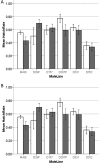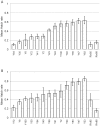A re-examination of Wolbachia-induced cytoplasmic incompatibility in California Drosophila simulans
- PMID: 21799900
- PMCID: PMC3143165
- DOI: 10.1371/journal.pone.0022565
A re-examination of Wolbachia-induced cytoplasmic incompatibility in California Drosophila simulans
Erratum in
-
Correction: A Re-Examination of Wolbachia-Induced Cytoplasmic Incompatibility in California Drosophila simulans.PLoS One. 2015 Sep 8;10(9):e0138050. doi: 10.1371/journal.pone.0138050. eCollection 2015. PLoS One. 2015. PMID: 26348356 Free PMC article. No abstract available.
Abstract
Background: In California Drosophila simulans, the maternally inherited Riverside strain Wolbachia infection (wRi) provides a paradigm for rapid spread of Wolbachia in nature and rapid evolutionary change. wRi induces cytoplasmic incompatibility (CI), where crosses between infected males and uninfected females produce reduced egg-hatch. The three parameters governing wRi infection-frequency dynamics quantify: the fidelity of maternal transmission, the level of cytoplasmic incompatibility, and the relative fecundity of infected females. We last estimated these parameters in nature in 1993. Here we provide new estimates, under both field and laboratory conditions. Five years ago, we found that wRi had apparently evolved over 15 years to enhance the fecundity of infected females; here we examine whether CI intensity has also evolved.
Methodology/principal findings: New estimates using wild-caught flies indicate that the three key parameters have remained relatively stable since the early 1990s. As predicted by our three-parameter model using field-estimated parameter values, population infection frequencies remain about 93%. Despite this relative stability, laboratory data based on reciprocal crosses and introgression suggest that wRi may have evolved to produce less intense CI (i.e., higher egg hatch from incompatible crosses). In contrast, we find no evidence that D. simulans has evolved to lower the susceptibility of uninfected females to CI.
Conclusions/significance: Evolution of wRi that reduces CI is consistent with counterintuitive theoretical predictions that within-population selection on CI-causing Wolbachia does not act to increase CI. Within taxa, CI is likely to evolve mainly via pleiotropic effects associated with the primary targets of selection on Wolbachia, i.e., host fecundity and transmission fidelity. Despite continuous, strong selection, D. simulans has not evolved appreciably to suppress CI. Our data demonstrate a lack of standing genetic variation for CI resistance in the host.
Conflict of interest statement
Figures






Similar articles
-
Loss of cytoplasmic incompatibility and minimal fecundity effects explain relatively low Wolbachia frequencies in Drosophila mauritiana.Evolution. 2019 Jun;73(6):1278-1295. doi: 10.1111/evo.13745. Epub 2019 Apr 29. Evolution. 2019. PMID: 31001816 Free PMC article.
-
Cytoplasmic incompatibility in Drosophila simulans: dynamics and parameter estimates from natural populations.Genetics. 1995 Aug;140(4):1319-38. doi: 10.1093/genetics/140.4.1319. Genetics. 1995. PMID: 7498773 Free PMC article.
-
From parasite to mutualist: rapid evolution of Wolbachia in natural populations of Drosophila.PLoS Biol. 2007 May;5(5):e114. doi: 10.1371/journal.pbio.0050114. PLoS Biol. 2007. PMID: 17439303 Free PMC article.
-
Wolbachia infections in Drosophila melanogaster and D. simulans: polymorphism and levels of cytoplasmic incompatibility.Genetica. 2004 Mar;120(1-3):51-9. doi: 10.1023/b:gene.0000017629.31383.8f. Genetica. 2004. PMID: 15088646 Review.
-
Sperm chromatin remodelling and Wolbachia-induced cytoplasmic incompatibility in Drosophila.Biochem Cell Biol. 2003 Jun;81(3):229-40. doi: 10.1139/o03-053. Biochem Cell Biol. 2003. PMID: 12897857 Review.
Cited by
-
Evolutionary Ecology of Wolbachia Releases for Disease Control.Annu Rev Genet. 2019 Dec 3;53:93-116. doi: 10.1146/annurev-genet-112618-043609. Epub 2019 Sep 10. Annu Rev Genet. 2019. PMID: 31505135 Free PMC article. Review.
-
Wolbachia in the spittlebug Prosapia ignipectus: Variable infection frequencies, but no apparent effect on host reproductive isolation.Ecol Evol. 2021 Jul 4;11(15):10054-10065. doi: 10.1002/ece3.7782. eCollection 2021 Aug. Ecol Evol. 2021. PMID: 34367558 Free PMC article.
-
Comparative analysis of Wolbachia maternal transmission and localization in host ovaries.Commun Biol. 2024 Jun 14;7(1):727. doi: 10.1038/s42003-024-06431-y. Commun Biol. 2024. PMID: 38877196 Free PMC article.
-
Loss of cytoplasmic incompatibility and minimal fecundity effects explain relatively low Wolbachia frequencies in Drosophila mauritiana.Evolution. 2019 Jun;73(6):1278-1295. doi: 10.1111/evo.13745. Epub 2019 Apr 29. Evolution. 2019. PMID: 31001816 Free PMC article.
-
Stability of the wMel Wolbachia Infection following invasion into Aedes aegypti populations.PLoS Negl Trop Dis. 2014 Sep 11;8(9):e3115. doi: 10.1371/journal.pntd.0003115. eCollection 2014 Sep. PLoS Negl Trop Dis. 2014. PMID: 25211492 Free PMC article.
References
-
- Hoffmann AA, Turelli M, Simmons GM. Unidirectional incompatibility between populations of Drosophila simulans. Evolution. 1986;40:692–701. - PubMed
-
- Binnington KC, Hoffmann AA. Wolbachia-like organisms and cytoplasmic incompatibility in Drosophila simulans. J Invertebr Pathol. 1989;54:344–352.
Publication types
MeSH terms
LinkOut - more resources
Full Text Sources
Medical
Molecular Biology Databases
Research Materials

